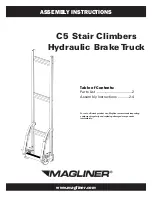
transmissions. Be sure to read the shift pattern
decal on the dash for the operating instructions
for the specific transmission installed in your ve-
hicle.
9-Speed RT, RTO, and RTX Models
Eaton Fuller 9-speed transmissions have a 5-speed
front section, and a 2-speed rear range section. On
the RT-8609 and all "A" and "B" ratio transmissions,
the low gear is used only as a starting ratio. On "R"
ratio transmissions, the high gear is used only as the
top gear. The remaining gear positions of the above
transmissions are used once in the low range and
once in the high range. See
Fig. 8.15
for the shift
patterns.
NOTE: The 3rd/7th and 4th/8th shift positions in
the RT (direct ratio) and RTX-B (overdrive ratio)
transmissions are opposite of the RTO (over-
drive ratio) transmissions. The RTX-R ratio
transmissions have the 1st/5th shift positions
where LOW is in the A and B ratio transmis-
sions. The top gear in the RTX-R ratio transmis-
sions is called 9th gear.
10-Speed RT, RTO, RTLO, and RTX
Models
Eaton Fuller 10-speed transmissions have ten selec-
tive, evenly-spaced forward ratios. Each transmission
has a 5-speed front section, and a 2-speed rear
range section. The ten forward speeds are obtained
by twice using a 5-speed shift pattern: the first time
in low range, the second time in high range. See
Fig. 8.16
for the shift patterns.
NOTE: The 4th/9th and the 5th/10th shift posi-
tions in the RT (direct ratio) and RTX (overdrive
ratio) transmissions are directly opposite in the
RTO (overdrive ratio) transmissions.
Operation, Eaton Range-Shift
1.
When operating off-highway, or under adverse
conditions, always use low gear (if so equipped)
when starting to move the vehicle.
When operating on-highway, with no load, or
under ideal conditions, use 1st gear when start-
ing to move the vehicle (except when equipped
with a 9-speed RTO transmission, then always
start in low gear).
For all conditions, use the highest gear that is
still low enough to start the vehicle moving with
engine idling, and without slipping the clutch
excessively.
2.
Use the clutch brake to stop gear rotation when
shifting into low (or 1st) or reverse when the ve-
hicle is stationary. The clutch brake is actuated
by depressing the clutch pedal all the way to the
floor.
For normal upshifts and downshifts, only a partial
disengagement of the clutch is necessary to
break engine torque.
3.
Do not make range shifts with the vehicle moving
in reverse gear.
4.
Never attempt to move the range preselection
lever with the gear shift lever in neutral while the
vehicle is moving. Preselection with the range
preselection lever must be made prior to moving
the shift lever out of gear into neutral.
5.
Do not shift from high range to low range at high
vehicle speeds.
6.
Double-clutch between all upshifts and down-
shifts.
7.
After your shifting ability improves, you may want
to skip some of the ratios. This may be done
only when operating conditions permit, depend-
ing on the load, grade, and road speed.
Upshifting
1.
Position the gear shift lever in neutral. Start the
engine, and bring the air system pressure up to
100 to 120 psi (689 to 827 kPa).
2.
Position the range preselection lever down, into
low range.
3.
Depress the clutch pedal to the floor; shift into
low or 1st gear (
Table 8.1
), then engage the
clutch, with the engine at or near idle speed, to
start the vehicle moving. Accelerate to 80 per-
cent of engine governed speed.
4.
Shift progressively upward from low or 1st gear,
to the top gear in low range (
Table 8.1
), double-
clutching between shifts, and accelerating to 80
percent of engine governed speed.
Transmissions
8.16







































